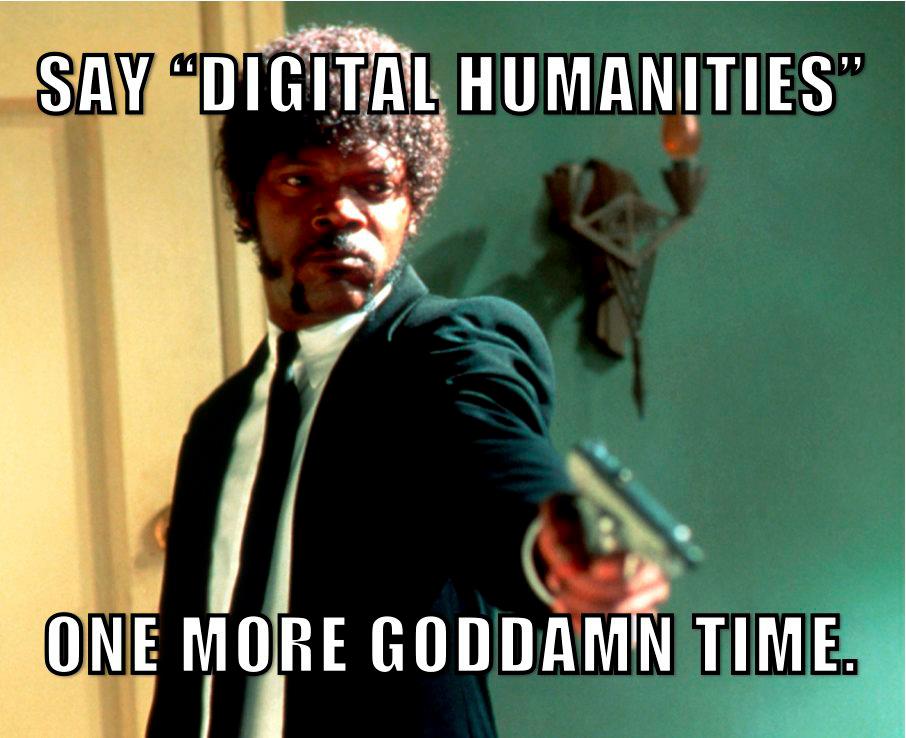I generally don’t think of myself as a person who is “web-savvy.”
While I have dabbled here and there with various programs and I took some
programming classes in high school, mostly I stick to the “holy three”: MS
Office, Internet browsers, and some very user-friendly photo-editing programs.
With the advent of “Digital Humanities,” a movement in the academy that functions
mostly, I think, to make us Ivory Tower dwellers seem like credible sources of
income to University administrators, I have felt somewhat behind. My web
presence is minuscule and cannot, I thought, compare to that of even the most
backward of Millennial-gen kids out there.
 |
| This meme sums up my usual feelings for the term "digital humanities." I mean, no one really knows what it means...So stop using it! |
I mean, this new generation, the generation I’m currently
teaching—you know, the kids who never breathed a minute of the 80s?—never lived
during a non-Internet era. They grew up AIM chatting, emailing, and texting.
9/11 is something that happened when they were ten years old—or younger. They
probably never used dial-up internet, never used mIRC or ICQ, never had to
worry about mom and dad picking up the house phone and disconnecting them from
a Very Important chat room discussion.
From what I read about on the web and hear on the radio
and TV, this generation is connected: Facebook is the least of it. They
Twitter, they Instagram, they blog, they code, they make podcasts and seek fame
through YouTube videos. In class, I see them frequently take a photo of what I’ve
written on the board instead of writing it down. They use Ipads to take notes
on (if they bother to take notes), and nearly all of them have smart phones.
They freely admit to being addicted to their phones and most of them walk
around campus with an ear bud or two connecting them to their playlists.
So I am consistently flabbergasted when students display
a basic lack of computer and Internet know-how. Without fail, they don’t know
how to insert page numbers, alter margins, or run spell check (though that last
one might be pure laziness). Despite having a powerful resource in their purse
or pocket, they regularly forget? refuse? can’t be bothered to? look up a word
in an assigned text that they don’t know. Even if the word is in the title of
the story we are reading.
Now, you might say, well, these examples merely point to
the laziness of the Millennials, their sense of entitlement, or their lack of
basic learning skills that resulted from No Child Left Behind and its emphasis
on testing over teaching. So I now progress to the more pointed examples. In
the last two years, the writing program at my institution has changed over from
paper portfolios to ePortfolios through a website called “Digication” (terrible
word). This saves pounds and pounds of paper and is much easier to grade as
well, as instructors are liberated from having to carry around said portfolios.
The portfolios take a little bit of manipulation on the part of the students,
as they require one to use Google Drive, to change the privacy settings, and then
to link the documents to the appropriate spot in the ePortfolio.
Mind you, Digication is a very intuitive. It’s been years
since I built my own website, but the interface on Digication is probably
easier than that of MS Frontpage, which I used back in 2003. Pasting in the
links consists of highlighting the word you would like to function as the link,
pressing the button that says “insert link,” and then pasting in the hyperlink—much
like on a blog interface. I was somewhat stunned when students had me
running around the classroom today, troubleshooting the most basic of issues. Suddenly
I felt like a real web babe, capable of figuring things out on my own in the
wacky web world! I felt something I had never felt before: I know web stuff!
And more importantly, I’m not scared to learn more if called on to do so. I
grew up tinkering with the web and computers: maybe not as much as others who
might have what we call a “natural talent” for the thing, but I've had my fair
share of tinkering.
My students seem to have no sense of tinkering, of
fiddling with something long enough until a solution emerges. They simply raise
their hands when they can’t figure it out and ask for the answer. In the case
of the ePortfolios, the answers were so simple, I wondered that my students weren't somewhat embarrassed to have asked. One student even asked how to
insert page numbers into a Google Doc, to which I replied, “Hit the ‘Insert’
button.”
Aside from my frustration with their over-reliance on my
hand-holding (I showed them how to do this as a class, first, and they still
needed my help for the entire class period) and my disappointment in their lack
of “tinkerage,” I ended up feeling quite proud of myself. I can fiddle! I can
tinker! I could take a class and learn more about different kinds of software
if I wanted to! Don’t get me wrong…I’m not going to take up any kind of
hardcore programming any time soon. But I felt enlightened by seeing their
limitations. Their limitations reminded me of my own skill set, and that I am
not as limited, technologically, as I thought I was. Digital humanities? Bring
it on! Web presence? I’ll show you web presence!
I’m one viral video away from a full-on interweb
takeover.
-UK
No comments:
Post a Comment